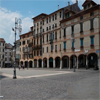

BROWSE HERE
Piazza Libertà, once 'piazza dei Signori', is the showcase for the Sunday stroll. Obtained with the filling of the moat that encircled the second circle of walls of Bassano, it was first called Piazza San Giovanni, from the name of the church that had arisen there in 1308. From 1867 it was dedicated to Vittorio Emanuele II king of Italy and during the second world conflict was called piazza del Popolo, then piazza Libertà. At the west end of the square, on two columns, a statue with the Lion of St. Mark stands, symbol of Venetian domination, and a statue of Saint Bassiano, patron saint of the city, by the Bassanese sculptor Orazio Marinali (1643-1720). The saint, bishop of Lodi between the fourth and fifth centuries, never landed on the banks of the Brenta: the Bassanesi, however, chose him as protector in 1509 for the similarity of his name to that of their city and for its thaumaturgical faculties against the recurrent plagues. The square is the nodal point of the city where the main streets of the center converge, facing prestigious buildings to the north, including the houses of the ancient Stamperia Remondini (which brought the name of Bassano around the world) and the Loggia del Comune , and to the south the imposing neoclassical façade of the church of San Giovanni.




 nfo
nfo








